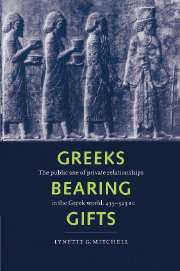Book contents
- Frontmatter
- Contents
- Preface
- Abbreviations
- 1 Philia
- 2 Philia and the polis
- 3 Philia and political activity
- 4 Magisterial appointments: Sparta
- 5 Magisterial appointments: Athens
- 6 Persia and the Greeks
- 7 Athenians and Thracians
- 8 Philip and the Greeks
- 9 Alexander
- 10 Friendship and ideology
- Appendix I Magistrates with connections
- Appendix II Notes on magistrates for the years 435–323 BC
- Bibliography
- Indexes
2 - Philia and the polis
Published online by Cambridge University Press: 06 July 2010
- Frontmatter
- Contents
- Preface
- Abbreviations
- 1 Philia
- 2 Philia and the polis
- 3 Philia and political activity
- 4 Magisterial appointments: Sparta
- 5 Magisterial appointments: Athens
- 6 Persia and the Greeks
- 7 Athenians and Thracians
- 8 Philip and the Greeks
- 9 Alexander
- 10 Friendship and ideology
- Appendix I Magistrates with connections
- Appendix II Notes on magistrates for the years 435–323 BC
- Bibliography
- Indexes
Summary
The only reward of virtue is virtue; the only way to have a friend is to be one.
Ralph Waldo Emerson, FriendshipJust as people relate to each other in different ways, there were also a number of ways in which states could relate to each other: for example, as mother-city and colony, bilateral allies, members of a federation of states like the fourth-century Arcadian Federation, members of a league with a hegemon such as the Peloponnesian League, or even members of an empire such as the fifth-century Athenian empire. Each of these relationships were different from each other and the partners in the relationship were expected to relate to each other and interact with each other on a variety of levels.
In fact, in many ways interstate relations reflected personal relations, and states qua states copied relationships found in the private sphere, so that the repertoire of exchanges in both public and private relationships were in many cases very similar, if not the same. This mirroring of private models and repertoires in the interstate sphere is reflected in the terminology of some early alliances. For example, in the middle of the sixth century Sybaris and the Serdaei formed a friendship (philotes) with each other, and in about 550 Croesus of Lydia formed a xenia and alliance with the Spartans against Persia, complete with an exchange of gifts.
- Type
- Chapter
- Information
- Greeks Bearing GiftsThe Public Use of Private Relationships in the Greek World, 435–323 BC, pp. 22 - 40Publisher: Cambridge University PressPrint publication year: 1998



